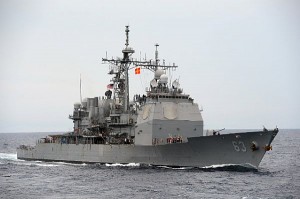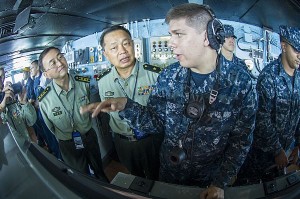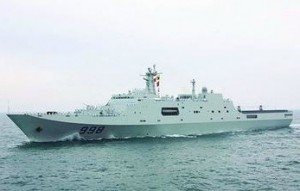 Upon further review of the L’affair Cowpens, where the USS Cowpens (CG-63) and a Chinese ship engaged in a little “irresponsible” pas de deux, I must wonder if it was a planned piece of provocation.
Upon further review of the L’affair Cowpens, where the USS Cowpens (CG-63) and a Chinese ship engaged in a little “irresponsible” pas de deux, I must wonder if it was a planned piece of provocation.
But, before we examine the confrontation in greater detail, let me highlight a fascinating Reuters piece published 7 November, almost exactly a month before the 5 December Cowpens incident. The article, “Off China’s Coast, U.S Carrier Displays Teeth Behind The Pivot“, is strikingly prescient.
Here’s a quote:
“…just 30 km (19 miles) away is a lone Chinese naval frigate, well within the protective screen of U.S. ships and aircraft that protect the carrier across a vast swathe of the disputed South China Sea.
The officers of the Washington are hosting People’s Liberation Army officers on-board as part of efforts to engage a Chinese military wary of being contained by U.S. forces across Asia (Editor: see photo below). The frigate has not been invited.
The Washington strike group commander, Rear Admiral Mark Montgomery, stretches his arm to the left horizon where the frigate is obscured by haze and acknowledges such encounters by the rival powers are now more common.
“You can definitely see the Chinese navy is modernizing and expanding,” he said. “It would be a natural conclusion they would be operating in the vicinity of us.”
Montgomery said routine communication with Chinese naval ships was “professional” and that the U.S. navy was determined to aid the long-troubled relationship with “transparency and openness”.
“I don’t have any issues with them operating in the vicinity of our ships,” he said…”
Hmm. That was quite an aggressive story, chock full of details that would make Chinese policymakers grind their teeth a bit, no?
So, who would have thought that, a mere month after this article was published, that Chinese ships would go joust with an American cruiser that had, according to Chinese media sources, committed the venial sin of closing to within 27 miles of China’s first Carrier Strike Group’s inner defense layer?
Now, you might think reporters would have noted this Reuters story in their Cowpens coverage, and used it to further highlight the tolerance and professionalism of the U.S. Navy when faced with a similar “escort”. But, after the Cowpens incident, reporters simply overlooked this detailed Reuters vignette on the state of U.S./Chinese task-group trailings. Rather than explore the wider context, the semi-collective a-historical amnesia of the Western chattering classes kicked in, and nobody in the media (or the policymaking community) bothered to mention the fact that Chinese ships tag along with U.S. Strike groups–often at far more intimate distances.
And let’s not even mention China’s 2006 surfacing of Song Class sub in the midst of a carrier battle group…that’s just ancient history of no interest to modern newspaper readers, right?
(Insert long, heavy sigh).
 But let us put all that aside, and examine some particular aspects of the Cowpens incident. As I noted earlier, some will dismiss this confrontation as just another rogue act by an out-of-control local PLA(N) captain. But, to me, the whole incident has a well-calibrated feel to it, as a somewhat scripted piece of “Provocation Theatre”. And why not? Nothing raises the Chinese government’s (and the PLA(N)’s) profile than a successful push-back of an intrusive representative of nosy Western imperialism, right? And certainly new naval investments are meant to be used for national benefit, yes?
But let us put all that aside, and examine some particular aspects of the Cowpens incident. As I noted earlier, some will dismiss this confrontation as just another rogue act by an out-of-control local PLA(N) captain. But, to me, the whole incident has a well-calibrated feel to it, as a somewhat scripted piece of “Provocation Theatre”. And why not? Nothing raises the Chinese government’s (and the PLA(N)’s) profile than a successful push-back of an intrusive representative of nosy Western imperialism, right? And certainly new naval investments are meant to be used for national benefit, yes?
Though such a stunt isn’t something a Western Navy might do, it might well be a rational path if viewed from a different cultural perspective.
So…with that in mind, let’s examine the ship that approached the Cowpens–and while nobody on the US side has identified the vessel (which is, frankly, odd, since both the Cowpens and China know precisely what ship approached the cruiser), Chinese reports (and subsequent task group photos) suggest the ship sent to ward off the Cowpens was a big, modern Type 071 amphibious transport dock, or LPD.
Now, LPDs are not often included in Western Carrier strike groups. Despite some folks scoffing at the strike group’s composition, the inclusion of a modern 071 amphibious LPD in a carrier strike group may have been a bit of geopolitical genius (and, well, aside from that, it is also an opportunity for the semi-functional carrier and the LPD to tinker with helo-centric amphibious assault scenarios, ASW contingencies and, um, maybe disabled carrier recovery, too.).
But, politically, using a 20,000-ton 071 to challenge a Tico is a fascinating choice–the Chinese LPD is fast enough to engage the U.S. cruiser and big enough to intimidate the 6,900 ton cruiser…yet..an 071 does not carry sufficient indigenous armament to truly frighten the cruiser into over-reaction or a fear-driven miscalculation. But it certainly was big enough to put the cruiser immediately on the defensive.
Let’s put it this way–with any other available escort vessel in the Chinese fleet, there’d have been a slight chance the Chinese would come away from the confrontation with a loss of “face“. Had the Chinese strike group’s frigates and destroyers–whose structural resistance to shock are still a little iffy–had actually approached, they’d have likely been at a disadvantage had the Cowpens Commander decided to hold course and engage in some robust shouldering. Dispatching a big LPD eliminates the cruiser commander’s temptation to hold course and shoulder away vessels intruding upon his free passage in international waters.
 So…using the Type 071 as the provocateur may suggest the encounter was calibrated. And that is an important point for the chattering classes to consider.
So…using the Type 071 as the provocateur may suggest the encounter was calibrated. And that is an important point for the chattering classes to consider.
Planned provocation or not, one underlying goal of the U.S. is probably to get the Chinese Navy to a table someplace to hammer out shared operational understandings. If so, then the Navy needs to be savvy about exploitating alternative negotiating venues. The Chinese certainly are. Here’s retired Chinese Rear Admiral Yin Zhuo–a moderate, no less–offering a point of discussion:
“…when an American ship gets too close to a Chinese ship, “Then, sorry, we will stop you,” he said. He added: “The U.S. side did not violate international law and we did not violate international law.”
Ok, so, if the Chinese are signaling, via their moderate voice to the press, that 27 miles from a mysterious “inner defense layer” is the point where it’s ok for the Chinese Navy to start pushing and shoving, then, surely we can roll out a retired Admiral to dolefully suggest that America would be glad to see Chinese warships follow their own suggestions and stay, oh, 27 miles away from our Carrier task force group’s “inner defensive layer”. (or reverse it and say something like, “given the Chinese habit of coming within X miles of our vessels, we expect that we can do the same in the future.”
Not a perfect solution, but it is a firm response that puts naval behavior into a deal-making context..and that shift might get folks in China thinking a bit.
Now, I certainly don’t want to underestimate the power of indignation in building regional sympathy. But my underlying sense is that it would be more stable (and safer) to start moving away from a “provocation spiral” towards a bumpy (pun intended) relationship that looks vaguely like a negotiation.
Indignation at provocations without demanding compensatory steps (like, say, starting to keep Chinese ships 27 miles away from our strike-group’s “inner defensive layer”) only invites more provocation. Which is dangerous. Well…it is, of course, only truly dangerous if we didn’t know beforehand we were going to be facing this sort of provocation in the first place.

{ 2 comments… read them below or add one }
Um….Thanks for your comments, but yes. It would be obvious to everyone that any surface ELINT of this group would be done by either a TICO or Burke….we just ain’t got much else larder capable of doing such a thing.
(That’s basically all the Chinese leadership needed to consider. But if you wanted to get a bit more speculative about their thought-process and explore how they might guess which ship would be dedicated to tail the task force….well….it would probably be reasonable for the Chinese to look at our assets available in the region, consider which ones were nearby and carried anti-ship capabilities like, oh, say, Harpoons, and then, out of THAT increasingly tiny subset, ID Cowpens as the likely tail–given that Cowpens has been the ship the Navy has been most eager to shed (until relatively recently) I’d suspect an adversary might think the ship, as a somewhat expendable asset, be the right fit for this sort of interesting duty…)
But that’s all un-necessary. If you assume the tail will be a DDG or CG, and you want to make a point about surveillance without risking surface combatants, the LPD is about the only Chinese asset capable of doing it.
As I said above, the LPD could add value to the task force regardless of any challenge–by serving as a recovery/tow vessel if something went wrong with the carrier, by supporting command and control, by supporting helo operations or exploring the use of the carrier in helo ops for ASW or Amphibious assault contingencies.
Thanks for reading!
So let’s get this straight. You’re implying that Chinese strategic-level leadership not only planned the interception of a US ship, the Chinese knew precisely which ship would be coming to conduct ELINT on their fleet exercise and included the LPD for the sole reason that it was sufficiently large enough to intimidate the Cowpens?
Isn’t it far more likely that WIB’s assessment is correct, that the LPD was included to give the Chinese a nice photo op they could distribute to their propagandists, and that the call was simply made by Chinese Admiral X on the spot that the LPD should be the one to try to push the Cowpens away because of its size? Or is there any evidence to back up any of these conclusions besides a set of coincidences which are tangential at best?